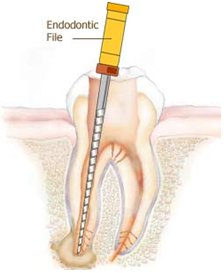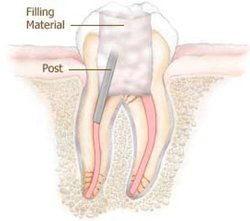WHAT IS RCT?
It is a procedure where a badly decayed or fractured or dead tooth is saved by removing its soft part (pulp) from the crown & the root of the tooth. Pulp is located in the core of the crown & root of the tooth. It is like mummifying a dead tooth to preserve it.
WHAT ARE THE INDICATIONS OF RCT?
- Decayed tooth
- Painful tooth
- Non-vital or dead tooth
- Trauma exposing the pulp
- Grossly attrided tooth
- Intentional RCT
HOW RCT IS DONE?
1. A Deep Infection
Root canal treatment is needed when an injury ora large cavity exposes the tooth’s pulp and the root becomes infected or inflamed.

2. Route to reach the pulp of the tooth
The dentist in Rohini may numb the tooth if it is painful. An opening is made through the crown of the tooth to the pulp chamber.

3. Removing the Infected/Inflamed Tissue
Special files are used to clean the infection andunhealthy pulp is removed out of the canals.Then they shape the canals for the filling material. Irrigation is used to help clean the canals and remove debris.

4. Filling the Canals
The canals are filled with a permanent inert rubber material called gutta-percha cones. This helps to keep the canals free of infection or contamination & fills the dead space.

5. Rebuilding the tooth
A temporary filling material is placed on top of the gutta-percha to seal the opening. The filling remains until the tooth receives a permanent filling or a crown. A crown, sometimes called a cap is placed over the top of the tooth. It looks like a natural tooth

6. Extra Support
In some cases, a post is placed into the root next to the gutta-percha. This gives the crown more support.

7. The Crowning/capping of the root canal treated tooth
To prevent the Root canal treated tooth from fracture, an artificial hollow dental crown is constructed & cemented over it.

WHAT ARE THE ADVANTAGES OF RCT OVER OTHER TREATMENT PROCEDURES?
- In case of deeply carious tooth the only treatment options are removal of tooth or the root canal treatment (RCT). However root canal treatment (RCT) is very conservative procedure which saves the natural tooth.
- Subsequently root canal treatment (RCT) prevents the bone loss and maintains the stability of the adjacent tooth.
- Most of the time the pain is related to the pulp tissue only and the procedure is more or less painless.
- As compared to other teeth replacement procedures after extraction, saving the natural tooth by root canal treatment (RCT) is quite cost effective & better option.
